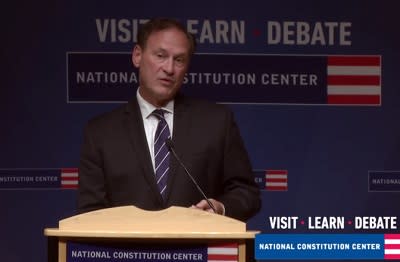Justice Samuel Alito on the Bill of Rights’ meaning here and globally
Supreme Court Associate Justice Samuel Alito spoke at the National Constitution Center in Philadelphia on Monday night about the enduring legacy of the Bill of Rights and how the Bill has affected other nations.
The Justice spoke at a special preview event for an upcoming exhibition at the Center that will feature an original copy of the Bill of Rights on loan from the New York Public Library, in the new George H.W. Bush Gallery opening later this year.
“This has been an important night for me in the work that I do. For many years, I have been involved in deciding cases regarding provisions in the Bill of Rights,” Alito noted. “New York can claim the title of the birthplace of the Bill of Rights,” Alito said about the origins of the document that was adopted when Congress met in New York City in 1789.
But he noted that Philadelphia has “deeper connections” to the Bill of Rights.
“The seed that became the Bill of Rights was planted here in Philadelphia in 1776 when the Continental Congress adopted the Declaration of Independence,” he said. “The Declaration of Independence proclaims the every person has a certain unalienable rights that are precious to us. The Bill of Rights codifies the promise of the Declaration of Independence., it codifies unalienable rights that are precious to us as Americans. ”
“The Bill of Rights also represents the completion of the work that was done across the street [from the National Constitution Center] in Independence Hall during the hot summer of 1787. That is where the body of our Constitution was adopted and sent to the state for ratification,” he added.
“We all know the story. When the body of the Constitution was completed, there were those who thought it was not complete, that the new, more powerful federal government that was created by the Constitution would threaten the liberty of the people. And therefore they thought it was imperative that there be explicit guarantees of rights in the Constitution. On the other hand, there were those who thought that the structure of the new government framed by the Constitution, the limitation of federal authority, the separation of powers, the system of dual sovereignty, provided better protection and sufficient protection for the rights of the people.”
“Both of those groups were powerful, and ultimately what occurred was a compromise. The Constitution was ratified… on the understanding that the Bill of Rights would be promptly framed and adopted and that is what happened.”
“And today we can see that both of those groups were perceptive. On the one hand, the government has grown to a size that the founding generation could never had imagined, and the Bill of Rights is vitally needed to keep the federal government and the state governments in check, to make sure they do not violate precious individual rights. At the same time, however, without the governmental structure that the Constitution created, the Bill of Rights would be like an arm without a body. Constitutional provisions protecting individual rights are worse than useless if they are not backed up by a governmental structure to enforce those rights. “
Alito also talked about the origins of the Supreme Court in Philadelphia. The Court had a brief initial session in New York, but it held its first extended meetings in Philadelphia when the capital moved south from New York (and before it moved farther south to Washington, D.C., in 1800).
“The Supreme Court heard its first cases across the street in the summer of 1791, and it was not long after that in the mid-1790s that the court began to hear arguments about the provisions of the Bill of Rights that were put into operation in that way. “
He also paid tribute to the former President George H.W. Bush, for whom the new gallery is named, noting President Bush’s distinguished war service, and how World War II inspired other nations to enforce their own versions of the Bill of Rights.
“For a long time, what our Constitution gave us was a declaration of rights that actually had teeth. And that is what is unique about our Bill of Rights. It actually has teeth. It was actually put into operation. And it is actually enforced. For a long time, that concept was an oddity. For more than 150 years, the idea that a legislative act is void, if it infringes the right of the people, found very few adherents, anywhere else in the world. “
“But World War II, where President George H.W. Bush fought with great distinction as a pilot, changed that. The enormity of the evil that was perpetrated by the Third Reich often under the veneer of legality, prompted people throughout the world, to rethink the whole question of rights.”
“And the American idea of an enforceable Bill of Rights began to catch on. All of the former Axis powers after World War II adopted new democratic constitutions that protect human rights and provide for judicial review of the constitutionality of government acts. And then after the collapse of the Soviet Union and the Warsaw pact during President Bush’s term, the newly liberated nations of Eastern Europe followed suit.”
Alito noted that President Bush said in 1991 that, “today we stand closer than ever before to achieving universal respect for human rights.”
“The promise of the Bill of Rights endures, and I hope this display of the Bill of Rights will help, if only in a small way to move us closer to that goal,” Alito concluded.
Recent Stories on Constitution Daily
Podcast: Jeffrey Rosen answers your Bill of Rights questions
10 little-known facts about President Theodore Roosevelt
Malala Yousafzai receives Liberty Medal in Philadelphia
Constitution Check: Will a brief 1972 ruling stop the same-sex marriage movement?


